Dry brush painting technique is a technique in which a painter uses a dry brush to ad very thick paint to the canvas. The paint penetrates into the weaving of the canvas leaving a fluffy trace that can be used to depict texture and details. For example, if you are painting the water a swift stroke of white with a dry brush can depict the sun rays on the water surface.
In order to achieve a dry brush stroke use a dry brush and a small amount of very thick paint. Drag the brush over a dry rag to remove any extra paint and use the brush to go over the surface of the paint with a swift move. Movement of the brush should resemble those you use when sketching with a pencil. Make sure that there is not too much paint on the brush.
Natural, scattered quality of the spreads made with a dry brush is very suitable for painting rough surfaces like rocks, tree barks or the foam on the waves but can also be implemented in more delicate details like the clouds, leaves and grass.

Bread
In order to paint this you will need :
- Primmed canvas
- Filbert hog bristle brush number 2
- Flat hog bristle brush number 8
- Flat hog bristle brush number 10
- Odourless mineral spirits
- A rag
- Charcoal pencil
The colors you will need are: Ochre Yellow, Van Dyke Brown, Titanium White, Venetian Red, Spectrum Yellow and Cobalt Purple.
Sketching
Prepare a very thin mixture of Ochre Yellow and Van Dyke Brown heavily diluted with mineral spirits and use it to paint the entire surface of the canvas with flat brush number 8. While the paint is still wet rub it with a clean soft rag soaked with mineral spirits. Leave the canvas to dry for about two hours. Using the rag gives you a brighter surface without any visible brush strokes.
Sketch the composition using charcoal pencil making sure that everything is positioned well on the canvas. Use a clean dry rag to remove residue and dust left from the charcoal so the oil paints wouldn’t get murky when you start painting.
With filbert brush number 2 go over the charcoal contours using Van Dyke Brown. Use undiluted color and work with a dry brush each time slowly dragging the paintbrush over a dry rag to remove any unneeded paint of it.

Adding The Details
Mix Titanium White with a little bit of Ochre Yellow to make the color warm and use it to paint the wall in the background and the tablecloth with flat hog bristle brush number 10.
You will notice how dry transparent paint allows the color of the surface to go through it. Use the same color to paint the brightest areas on the bread and the cutting board.
With the mixture of Venetian Red, Ochre Yellow and white paint the cutting board and the bread again using transparent dry paint. Paint the piece of the bread that is cut off using the combination of Van Dyke Brown,
Spectrum Yellow and a little bit of white. Create saturated dark brown mixing Van Dyke Brown and Venetian Red and use it to paint the burnt crust on the top of the bread. Ad a little bit of Spectrum Yellow to that mixture to make the tone warm golden brown and use it to paint light areas on the bread and the cutting board.

Paint the shadow that the bread creates on the wall with the mixture of Van Dyke Brown, Ochre Yellow and a bit of white. Add the paint in different directions.
With filbert brush number 2 add dark reflections on the blade of the knife using the mixture of Van Dyke Brown, Ochre Yellow and Venetian Red.
Using flat brush number 8 add saturated, warm goldish tones to the bread with Ochre Yellow.
Don’t mind if the paint goes over the edges of the object contour you can fix that in a later stage of painting.
Add a bit of Venetian Red to Ochre and paint the shadow of the bread on the cutting board. With the same paint touch each spot on the model that appears to be too bright.
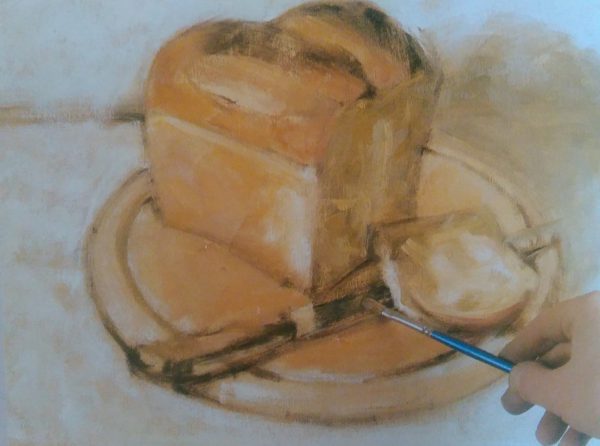
Finishing Touches
Make the color on top of the bread darker using Venetian Red mixed with Van Dyke Brown. Use the same color to make the crust on the sliced piece darker too.
Using the edge of the brush add thicker layers of Van Dyke brown to the crust of the bread to make it look a bit burnt. With the same paint depict the grainy structure on the lateral side of the bread.
You will see how the dry brush technique helps you depict the crust like grainy crisp texture.
The grainy texture of the canvas adds to the impression dispursing the paint that is added in such a manner.
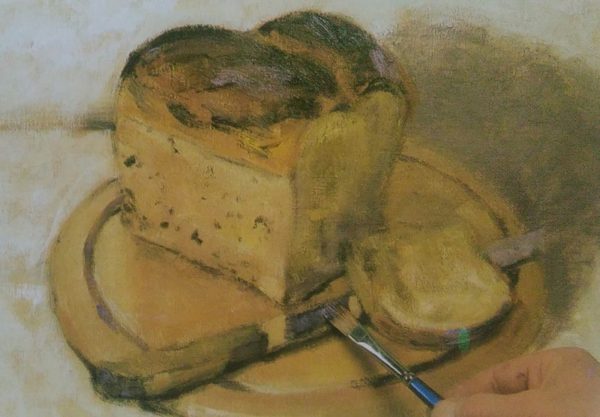
Make the shadows under the knife darker using Van Dyke Brown mixed with Venetian Red.
Mix Cobalt Purple with a little bit of Van Dyke Brown and smear the paint on the shadow on the wall using a dry brush.
Twist and turn the brush making the colors blend giving a warm purple glow to the shadow.Use the same mixture to paint the shadow in the bottom of the cut side of the bread.
With the mixture of Cobalt Purple and white paint
the brightest areas on the edge of the knife, on the bread crust and on the cut off slice of bread. Use that paint also for the edge of the cutting board. Add purple in traces on the background to harmonize the painting.
Mix Titanium White with a little bit of purple and pink and take a small amount of it with the tip of flat brush number 10. Smear the paint on the wall to point out the bread. Using TItanium White, Ochre Yellow and a little bit of Spectrum Yellow create warm white and apply it on the tablecloth.
Paint the ridges on the table cloth with purple mixture. For the brightest areas on the cutting board use Ochre Yellow and white added with the tip of the brush. Use the mixture of Titanium White, Ochre Yellow, Spectrum Yellow and a bit of Venetian Red to soften the tones on the cut side of the bread and the slice of bread.
With Filbert brush number 2 work on the contour of the knife using Van Dyke Brown. Paint the brightest areas on the blade using white, Ochre Yellow and purple. In the end, paint the brightest areas on the crust of the slice of bread using white, Ochre Yellow and Spectrum Yellow.

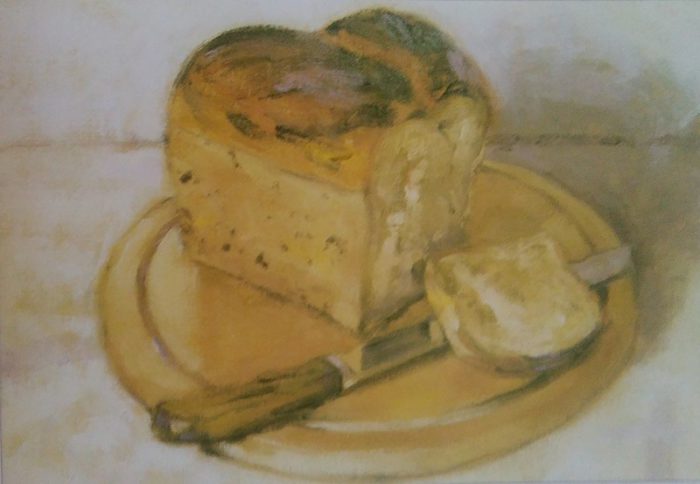

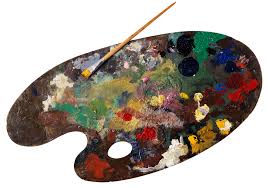
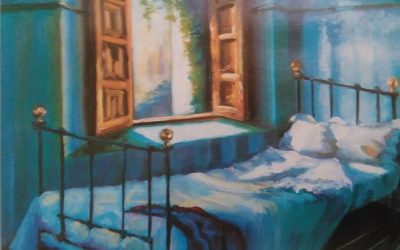
lovely painting skills dear
Thank you